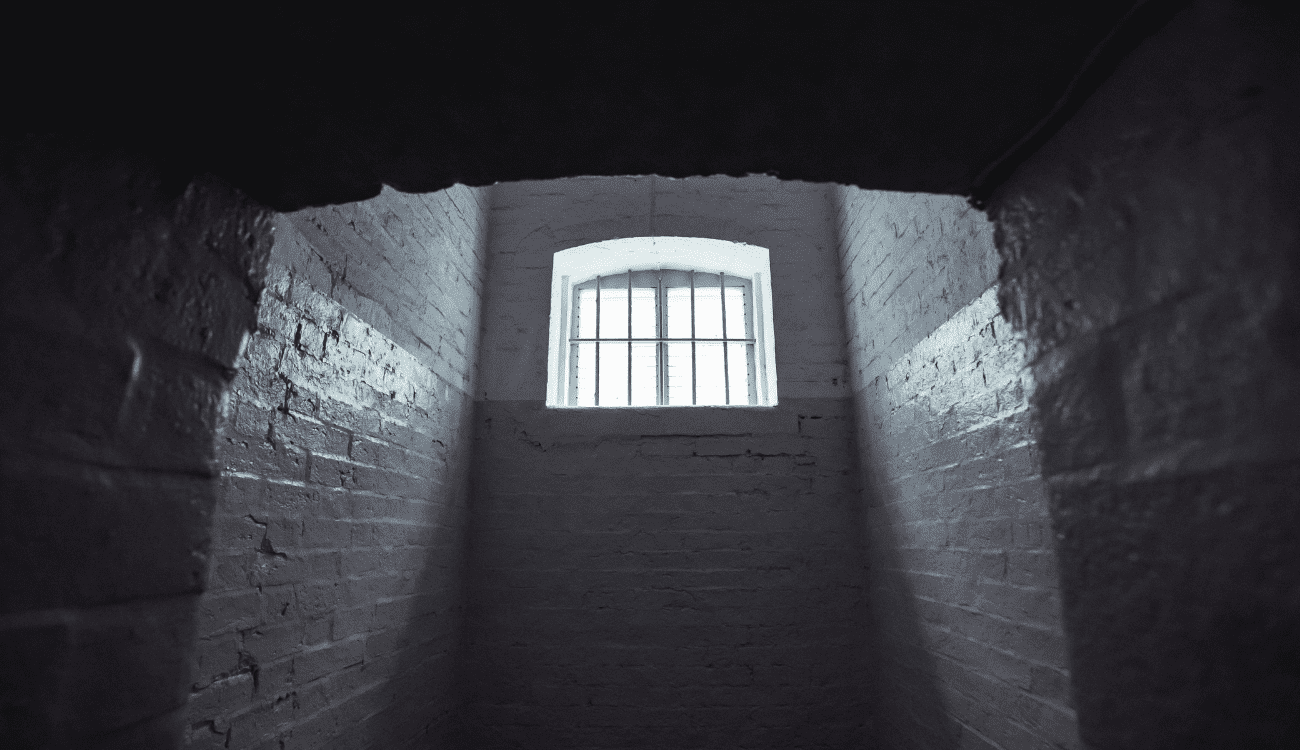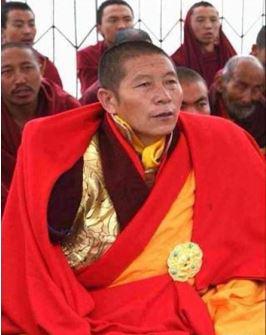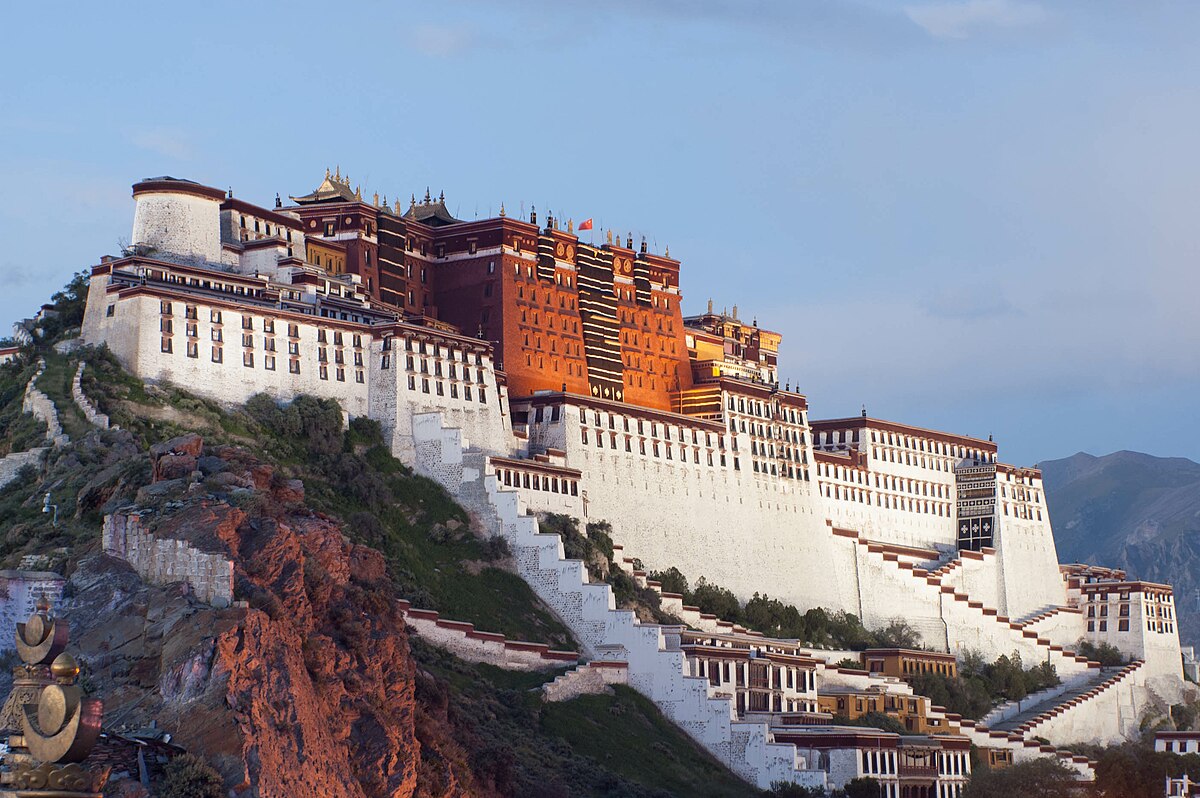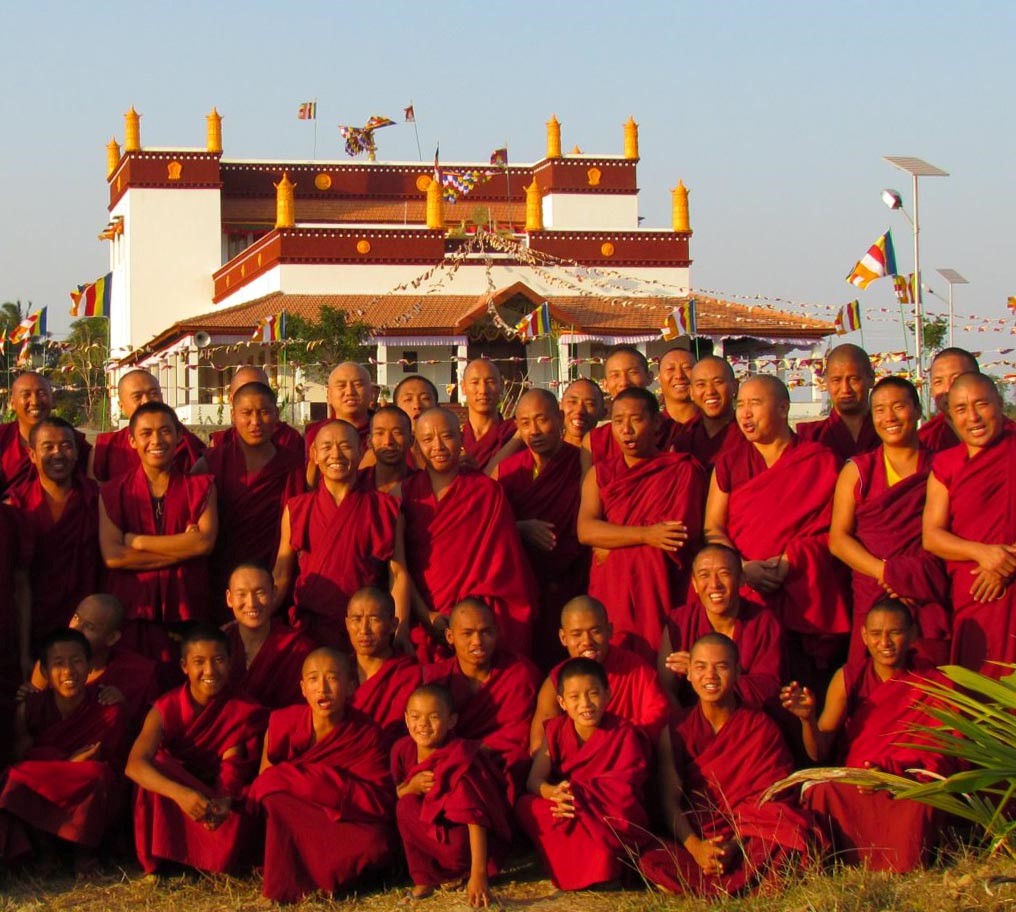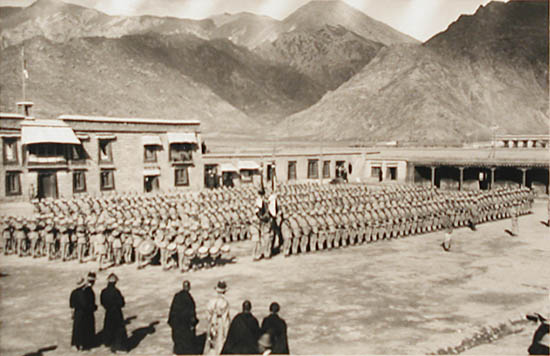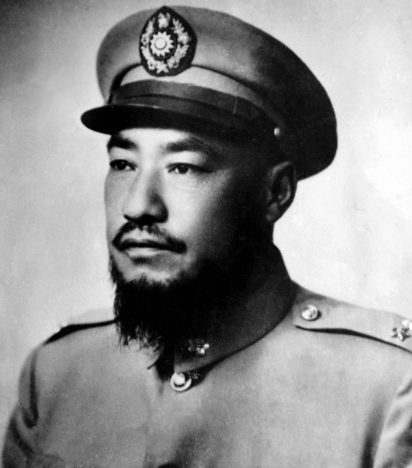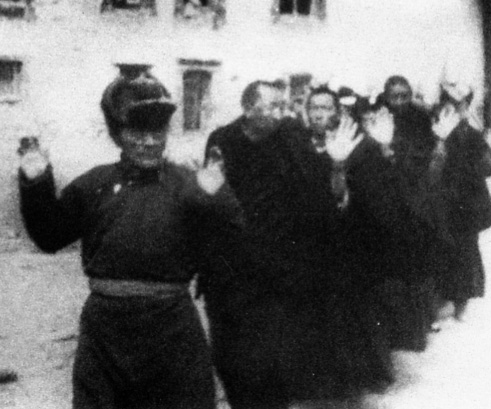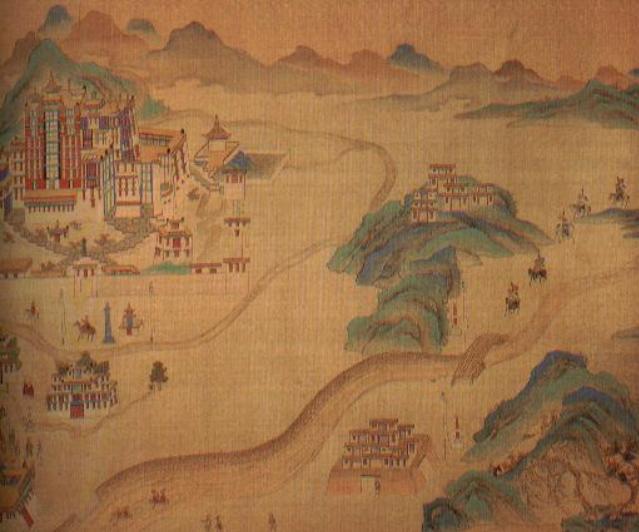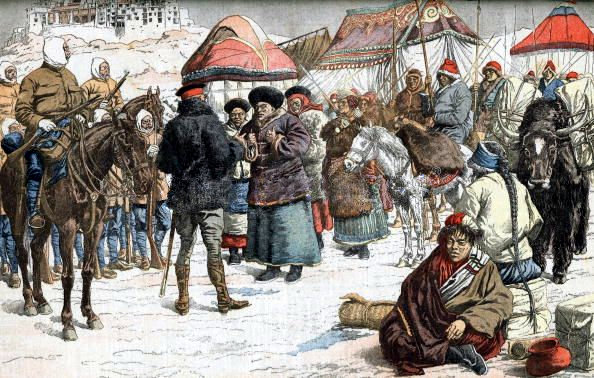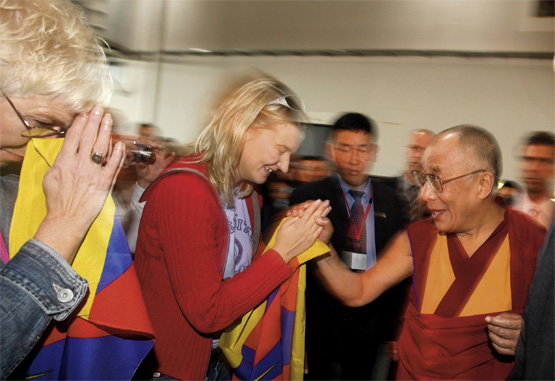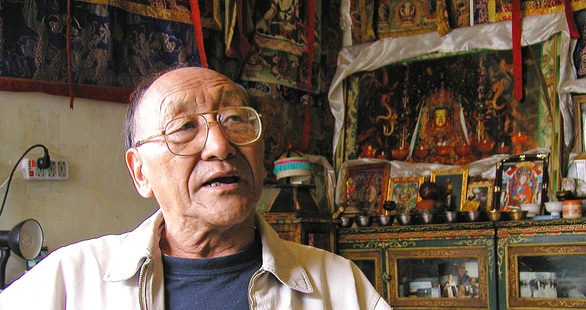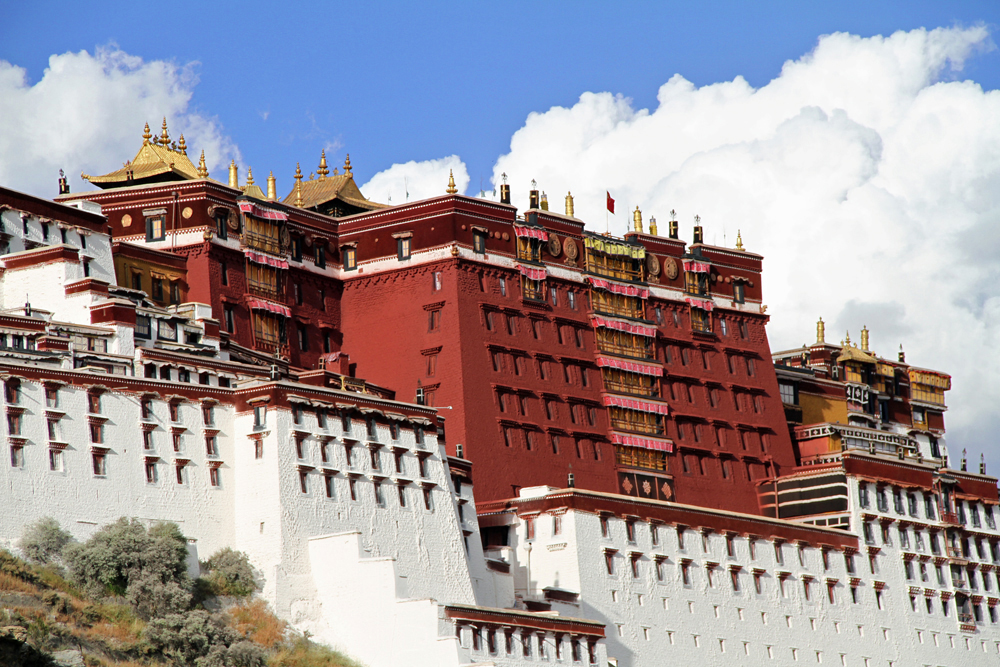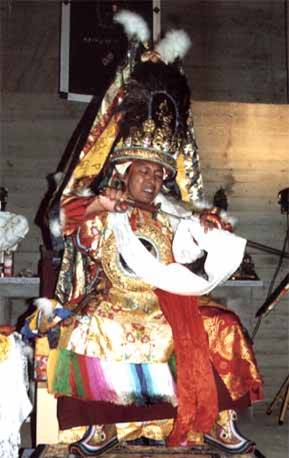The Tibetan state oracle
In the Tibet of old, the state oracle (or rather its human medium) lived, as one of the highest ranking lamas in the Nechung residence. “It” had at its command
a considerable “court” and celebrated its liturgies in a temple of its own. The predominant color of the interior temple was black. On the walls of the gloomy shrine hung mysterious weapons, from which great magical effects were supposed to emanate. In the corners lurked stuffed birds, tigers, and leopards. Pictures of terror gods looked back at the visitor, who suddenly stood in front of a mask of dried leather feared across the whole country. Among the chief iconographic motifs of the temple was the depiction of human ribcages.
The Tibetans can be described without exaggeration as being “addicted to oracles”. The most varied methods of augury and clairvoyance have been an everyday presence in the Land of Snows since time immemorial. The following types of oracle, all of which are still employed (among the Tibetans in exile as well), are described on an Internet site: doughball divination, dice divination, divination on a rosary, bootstrap divination, the interpretation of “incidental” signs, clairvoyant dreams, examining flames, observing a butter lamp, mirror divination, shoulder-blade divination, and hearing divination (HPI 10). When the “Great Fifth” seized worldly power in Tibet in the 17th century, he founded the institution of a state oracle so as to be able to obtain divinatory advice about the business of government. This is a matter of a human medium who serves as the mouthpiece of a particular deity. Still today, this form of “supernatural” consultation forms an important division within the Tibetan government in exile. The opinions of oracles are obtained for all important political events, often by the Fourteenth Dalai Lama in person. He is — in the accusations of his opponents — all but obsessed by divinations; it is primarily the prophecies of the state oracle which are mentioned. But before we examine this accusation, we should take a closer look at the history and character of this “state oracle”.
The Tibetan state oracle
In the Tibet of old, the state oracle (or rather its human medium) lived, as one of the highest ranking lamas in the Nechung residence. “It” had at its command a considerable “court” and celebrated its liturgies in a temple of its own. The predominant color of the interior temple was black. On the walls of the gloomy shrine hung mysterious weapons, from which great magical effects were supposed to emanate. In the corners lurked stuffed birds, tigers, and leopards. Pictures of terror gods looked back at the visitor, who suddenly stood in front of a mask of dried leather feared across the whole country. Among the chief iconographic motifs of the temple was the depiction of human ribcages.
At the beginning of an oracle session, the Nechung Lama is sent into a trance via all manner of ritual song and incense. After a while eyes close, his facial muscles begin to twitch, his brow becomes dark red and glistens with sweat. The prophet god then visibly enters him, then during his trance the medium develops — and this is confirmed by photographs and western eyewitness reports — almost superhuman powers. He can bend iron swords and, although he carries a metal crown weighing over 80 pounds (!) on his head, perform a wild dance. Incomprehensible sounds come from his foaming lips. This is supposed to be a sacred language. Only once it has been deciphered by the priests can the content of the oracle message be recognized.
The deity conjured up by the Nechung Lama is called
Pehar or
Pedkar. However often only his adjutant is invoked,
Dorje Drakden by name. This is because a direct appearance by
Pehar can be so violent that it threatens the life of his medium (the Nechung Lama).
Pehar has under his command a group of five wrathful gods, who together are called the “protective wheel”. It seems sensible to make a few thoughts about this prophesying god, who has for centuries exercised such a decisive influence upon Tibetan politics and still continues to do so.
In iconographic representations,
Pehar has three faces of different colors. He wears a bamboo hat which is crowned with a
vajra upon his head. In his hands he holds a bow and arrow, a sword, a cleaver, and a club. His mount is a snow lion.
Pehar’s original home lay in the north of Tibet, there where in the conception of the old Tibetans (in the
Gesar epic) the “devil’s country” was to be found. In earlier times he reigned as war god of the Hor Mongols. According to the sagas, this wild tribe was counted among the bitterest opponents of the pre-Buddhist Tibetans and their national hero,
Gesar of Ling.
Old documents from Tunhuang describe the Hor as “flesh-eating red demons” (Stein, 1993, p. 36). Their martial king had laid waste to the Land of Snows and stolen its queen, the wife of
Gesar of Ling. After terrible battles the Tibetan national hero defeated the rapacious Hors, to whom we are indebted for the word
horde, and won their commitment and that of their chief god,
Pehar, with an eternal oath of loyalty. Over the centuries the term
Hor was then used to refer to various Mongolian tribes, including those of Genghis Khan. Hence,
Pehar (the principal oracle god of the Dalai Lama) was originally a bitter arch-enemy of the Tibetans.
Where
Gesar had rendered the Mongol god harmless, it was the
Maha Siddha Padmasambhava (Guru Rinpoche) who brought Buddhism to Tibet who first succeeded in actually putting
Pehar to work. The saga tells how Guru Rinpoche pressed a
vajra upon the barbaric god’s head and thus magically mastered him. After this act,
Pehar was able to be incorporated into the Buddhist pantheon as a servant. For seven hundred years his chief residence was the founding monastery Samye, by the construction of which he had to assist as a “forced laborer”. About 900 years later the “Great Fifth” transported him (i.e., his symbol) to Nechung in the vicinity of the Drepung monastery and advanced the former war god of the Hor to state oracle. Since, after his “Buddhization”, he did not want to be reminded of his former defeat (by the national hero,
Gesar), not a single verse from the
Gesar epic was allowed to be cited in the Drepung monastery or at any other location where he had stayed.
The question soon arises as to why of all gods
Pehar, the former ferocious and cruel opponent of the Land of Snows, was given the delicate office of being a supernatural governmental advisor to the Tibetan “god-king”. Surely this would have sooner been the entitlement of a Bodhisattva like
Avalokiteshvara or a national hero like
Gesar of Ling.
With this question too, the key is to be sought in the “political theology” of the “Great Fifth”. We may recall that both the conferring of the title of
Dalai Lama and the establishment of the hierarch’s secular power were the actions of the Mongolians and not of the Tibetan people. In contrast, as we have reported, in the 17th century the national forces of the country were actually gathered under the kings of Tsang and around the throne of the Karmapa (the leader of the “red” Kagyupa sect). Thus, it does not take much fantasy to be able to sketch out why
Pehar was chosen as the advisor of the “yellow” Buddhist state (then represented by the Fifth Dalai Lama). It was expected of the former Mongolian god and opponent of Tibet that he tame the recalcitrant Tibetans (who supported the Karmapa). In this his interests were in complete accord with those of the “god-king”. Additionally, the “Great Fifth” himself was a descendant of an aristocratic family which traced its lineage back to the Hor Mongols.
Pehar, the later state oracle, is thus a foreign deity imposed upon the Tibetan people.
It is true that the oracle god has sworn an oath of loyalty, but it is — in the lamas’ opinion — by no means ruled out that he may one day break this and unleash his full vengeance upon the Tibetans who defeated him in times gone by. He has in his own words explained to Padmasambhava what will then happen. He will destroy the houses and the fields. The children of the Land of Snows will have to endure famine and will be driven insane. The fruit of the and will be destroyed by hail and swarms of insects. The strong will be carried off and only the weak shall survive. Wars shall devastate the roof of the world.
Pehar himself will interrupt the meditations of the lamas, rob their spells of their magic power, and force them to commit suicide. Brothers will rape their sisters. He will make the wisdom consorts (the
mudras) of the tantra masters bad and heretical, yes, transform them into enemies of the teaching who emigrate to the lands of the unbelievers. But first he shall copulate with them. “I,”
Pehar proclaims, “the lord of the temples, the stupas and scriptures, I shall possess the fair bodies of all virgins” (Sierksma, 1966, p. 165).
In the sphere of practical politics the recommendations of the Mongolian martial god have also not always been advantageous for the Tibetans. For example, he gave the Thirteenth Dalai Lama the catastrophic advice that he should attack the British army under Colonel Younghusband which led to a massacre of the Tibetan soldiers.
Current politics and the oracle system
One would think that the Tibetans in exile would these days have distanced themselves from such a warlike deity as
Pehar, who constantly threatens them with bloody acts of revenge, especially after their experiences at the hands of the Chinese occupying forces. One would further assume that, given the
Kundun’s strident professions of democracy
, the oracle system as such would be in decline or have even been abandoned. But the opposite is the case: in Dharamsala the divinatory arts, astrology, the interpretation of dreams, and even the drawing of lots still have a most decisive (!) influence upon the politics of the Tibetans in exile. Every (!) politically significant step is first taken once the mediums, soothsayers, and court astrologers have been consulted, every important state-political activity requires the invocation of the wrathful Mongolian god,
Pehar. This tendency has increased in recent years. Today there are said to be three further mediums (who represent different deities) whose services are made use of. Among these is a young and attractive girl from an eastern province of Tibet. Some members of the community of Tibetans in exile are therefore of the opinion that the various oracles misuse His Holiness the Fourteenth Dalai Lama for their own ends and force their will upon him.
Now, how does the “god-king” see this through his own eyes? “Even some Tibetans,” we learn from the
Kundun, “mostly those who consider themselves 'progressive', have misgivings about my continued use of this ancient method of intelligence gathering. But I do so for the simple reason that as I look back over the many occasions when I have asked questions of the oracle, on each one of them time has proved that his answer was correct” (Dalai Lama XIV, 1993 I, p. 312). “I not only believe in spirits, but in various kinds of spirits!”, His Holiness further admits, “... To this category belongs the state oracle Nechung (
Pehar). We consider these spirits reliable, then they have a long history without any controversy in over 1000 years” (
Tagesanzeiger (Switzerland), March 23, 1998).
Pehar determined the point in time in which the Dalai Lama had to flee Tibet and with the statement “that the shine of the 'wish-fulfilling jewel' [one of the Dalai Lama’s names] will light up in the West” predicted the spread of Buddhism in Europe and North America. (Dalai Lama XIV, 1993a, p. 154).
Even the aggression of his oracle god is not denied by the
Kundun: “ His [task], in his capacity as protector and defender, is wrathful. [!] However, although our functions are similar, my relationship with Nechung is that of commander to lieutenant: I never bow down to him. It is for Nechung to bow to the Dalai Lama” (Dalai Lama XIV, 1993 I, p. 312). This statement confirms once again that from a tantric viewpoint, the politics of the Tibetans in exile is not conducted by people, but by gods. As
Avalokiteshvara and the
Kalachakra deity, the Dalai Lama commands the Mongolian god, Pehar, to make predictions about the future. [1] The
Kundun’s comment in this quotation that his functions and the “functions” of
Pehar are “similar” is ambiguous. Does he want to allude to his own “wrathful aspect” here? On September 4, 1987 a new Nechung medium was enthroned in Dharamsala, since the old one had died three years before. His official confirmation was attained following a demonstrative trance session at which the
Kundun, cabinet members of the Tibetan government in exile and the parliamentary chairman were present. About two months later another séance was held before the Council of Ministers and a number of high lamas. This illustrious assembly of the highest ranking representatives of the Tibetan people shows how the political prophecies and instructions of the god
Pehar are taken seriously not just by the Dalai Lama but also by the “people’s representatives” of the Tibetans in exile. Thus, in political decisions neither reason nor the majority of votes, nor even public opinion have the last word, but rather the Mongolian oracle god.
Dorje Shugden—a threat to the Fourteenth Dalai Lama’s life?
Since 1996 at the latest,
Pehar and his Nechung medium have met with embittered competition from among the Tibetan’s own ranks. This is a matter of the tutelary and divinatory deity,
Dorje Shugden. In pictures,
Dorje Shugden is depicted riding grim-faced through a lake of boiling blood upon a snow lion. It is primarily conservative circles among the Gelugpas (the “Yellow Hats”) who have grouped around this figure. They demand the exclusive supremacy of the yellow sect (the
Gelugpas) over the other Buddhist schools.
This traditional political position of the
Shugden worshippers is not acceptable to the Fourteenth Dalai Lama (although he himself is a member of the yellow sect) because he is working towards an integration of all Tibet’s religious orientations, including the Bonpos. With the same resolve as the “Great Fifth” he sees a one-off chance to multiply the power of his own institution in a collective movement involving all schools. It is therefore not surprising that even the early history of
Dorje Shugden features an irreconcilable confrontation between the protective god and the Fifth Dalai Lama, which appears to be repeating itself today.
What took place on that occasion, and what has been the history of the recalcitrant
Shugden? The “pan-Buddhist” program of the “Great Fifth”, but especially his occult tendency towards the Nyingmapa sect, led the abbot of the powerful Drepung (Yellow Hat) monastery, Drakpa Gyaltsen, to organize a rebellion against the ruler in the Potala. The conspiracy was discovered and was not carried out.
The two oracle gods at daggers drawn: Shugden [l] and Nechung [r]
Most probably at the command of the in such matters unscrupulous god-king, the rebel was murdered first. Whilst the corpse was being burned on a pyre, a threatening cloud which resembled a huge black hand, the hand of the avenger, was formed by the ascending smoke. After his death the murdered lama, Drakpa Gyaltsen, transformed into a martial spirit and took on the fearsome name of
Dorje Shugden, which means the “Bellower of the Thunderbolt”. He continued to pursue his political goals from the beyond.
Shortly after his death — the legend reports — all manner of unhappy incidents befell the country. Towns and villages were afflicted with sicknesses. The Tibetan government constantly made wrong decisions, even the Fifth Dalai Lama was not spared. Every time he wanted to have a meal in the middle of the day, his victim (
Dorje Shugden) manifested himself as an invisible evil force, up-ended the dinner tables and damaged the “ His Holiness’s possessions”. [2] Ultimately it proved possible to subdue the vengeful spirit through all manner of rituals, but he did not therefore remain inactive.
With the assistance of a human medium, through whom he still today communicates with his priests, the abbot who had transformed into a protective god organized (from the beyond, so to speak) a oppositional grouping within the Yellow Hat (Gelugpa) order, who wanted (and still want) to enforce the absolute supremacy of their order by magical and practical political means. For example, at the beginning of the 20th century the invocation of
Shugden by the powerful Yellow Hat lama, Pabongka Rinpoche, was used to suppress the Nyingmapas and Kagyupas in eastern Tibet. An outright ritual war was fought out: “... whenever this [
Shugden] ritual was practiced in the Gelugpa monasteries, the surrounding monasteries of the other schools [performed] certain practices so as to check the negative forces again” (
Kagyü Life 21-1996, p. 34).
Nonetheless the “reactionary”
Shugden movement constantly gained in popularity, especially among members of the Tibetan nobility too. Later, this “sub-sect” of the Yellow Hats came to understand itself as a secret nest of resistance against the Chinese occupation force, since the traditional protectors of Tibet (
Palden Lhamo or
Pehar, for example) had allegedly betrayed and left the country. One of the chief representatives of the secret conservative alliance (Trijang Rinpoche) was a teacher of the Fourteenth Dalai Lama, who himself initiated his divine pupil into the
Shugden cult.
The reverence for
Shugden is likewise high among the Tibetans in exile, and is well distributed worldwide (everywhere where Gelugpas are to be found). A fifth, in some other versions even two-thirds, of the yellow sect are said to pray to the reactionary
dharmapala (tutelary spirit). But in the meantime the movement has also spread among Westerners. These are primarily from the
New Kadampa Tradition (NKT), an English-based grouping around the lama Geshe Kelsang Gyatso. The declaration of exclusion from his former monastery says of the latter that, “this demon with broken commitments, Kelsang Gyatso, burns with the flame of unbearable spite toward the unsurpassed omniscient XIV Dalai Lama, the only staff of life of religious people in Tibet, whose activities and kindness equal the sky” (Lopez, 1998, p. 195). His supporters provide online information about their conflict with Dharamsala under the name of the
Shugden Supporters Community (SSC).
The Kundun and Shugden
It is true that in the year 1976 the Fourteenth Dalai Lama had already declared that he did not wish for his person to associated in any way with
Dorje Shugden, especially because the worship of this “reactionary” spirit had come into conflict with three other
dharmapalas (tutelary gods) which he revered highly, the oracle god
Pehar, the terrible
Palden Lhamo, and the protective god
Dharmaraja. Rumors report of a dream of the
Kundun in which
Shugden and
Pehar had fought with one another. On a number of occasions
Pehar prophesied via the Nechung Lama that
Shugden was attempting to undermine the sovereignty of the
Kundun and thus deliver Tibet into the hands of the Chinese. The Mongolian god received unexpected support in his accusations through a young attractive female medium by name of Tsering Chenma, who, during the preparations for a
Kalachakra initiation (!) in Lahaul Spiti announced that 30 members of the
Dorje Shugden Society would attack the Dalai Lama in the course of the initiation. Thereupon the
Kundun’s security staff searched all present for weapons. Nothing was found and not a single representative of the
Shugden society was in attendance (Burns, Newsgroup 1).
Yet another, female (!) oracle was questioned about the Shugden affair. During the session and in the presence of the Dalai Lama, the woman is supposed to have fallen upon a monk and whilst she tore at his clothes and shook his head cried out: “This Lama is bad, he is following
Dorje Shugden, take him out, take him out” (Burns, Newsgroup 9).
The majority of the Tibetans in exile were naturally not informed about such incidents, which were more or less played out behind closed doors, and were thus most surprised at the sharpness and lack of compromise with which the
Kundun repeated his criticisms of the
Shugden movement in 1996.
On March 21, during the initiation into a particular tantra (
Hayagriva) he turned to those present with the following words: “I have recently said several prayers for the well-being of our nation and religion. It has become fairly clear that
Dolgyal [another name for
Shugden] is a spirit of the dark forces. ... If any of you intend to continue to invoke
Dolgyal [
Shugden], it would be better for you to stay away from this authorization, to stand up and leave this place. It is unfitting if you continue to sit here. It will be of no use to you. It will in contrast have the effect of shortening the life of the Gyalwa Rinpoche [of the Dalai Lama, that is, his own life]. Which is not good. If there are, however, some among you who want that Gyalwa Rinpoche [he himself] should soon die, then just stay” (
Kagyü Life 21-1996, p. 35).
At another location the
Kundun announced his fear that
Shugden was seeking to spoil all his pleasure in life via psychic terror: “You should not think that dangers for my life come only from someone armed with a knife, a gun or a bomb. Such an event is extremely unlikely. But dangers to my life may arise if my advice is constantly spurned, causing me to feel discouraged and to see no further purpose in life” (Kashag, HPI 11).
Such statements by His Holiness may imply that the Dalai Lama (and behind him the Bodhisattva
Avalokiteshvara) is very fearful of this vengeful spirit, which induced the Indian
Associated Press to make the mocking comment that, “a 350-year old ghost is haunting the Dalai Lama” (Associated Press, August 21, 1997, 2:54 a.m.). At any rate,, the god-king’s security service which protects his residence in Dharamsala in the meantime consists of 100 police officers.
The following statement by the
Kundun has been leaked from a secret meeting of influential exiled Tibetan politicians and high lamas which the Dalai Lama called to discuss the
Shugden case in Caux (Switzerland): “Everyone who is affiliated with the Tibetan Society of Ganden Phodrang government (Tibetan Government) should relinquish ties with Dhogyal (Shugden). This is necessary since it poses danger to the religious and temporal situation in Tibet. As for foreigners, it makes no difference to us if they walk with their feet up and their head down. We have taught Dharma to them, not they to us. ... We should do it [carry out this ban] in such a way to ensure that in future generations not even the name of Dholgyal [
Shugden] is remembered” (Burns, Newsgroup 1).
Numerous Tibetans who had in the past been initiated into the
Shugden cult by the personal teacher of the
Kundun, Trijang Rinpoche, and believed that through this they enjoyed His Holiness’s favor, saw themselves all at once betrayed after the ban and felt deeply disappointed. For the sophisticated Dalai Lama, however, the sectarian position of the “yellow fundamentalists” and “sectarians” was no longer bearable and quite obviously a significant obstacle on his mission to compel all sects to accept his absolute control and thus limit the supremacy of the Gelugpas. “This
Shugden spirit”, the
Kundun has said, “has for over 360 years created tensions between the Gelug tradition and the other schools. ... Some may [because of the ban] have lost trust in me. But at the same time numerous followers of the Kagyupa or Nyingma schools have recognized that the Dalai Lama is pursuing a truly non-sectarian course. I believe this
Shugden worship has been like an agonizing boil for 360 years. Now like a modern surgeon I have undertaken a small operation” (
Tagesanzeiger (Switzerland), March 23, 1998).
He then also branded the
Shugden cult as “idolatry” and as a “relapse into shamanism” (
Süddeutsche Zeitung, 1997, No. 158, p. 10). On March 30, 1996 the ban on the worship of Shugden was pronounced by governmental decree. The “mouthpiece” of the
Kundun in the USA, Robert Thurman, emotionally denounced the “sectarians” and publicly disparaged them as the “Taliban of Buddhism”.
In the meantime the accusations coming out of Dharamsala against the
Shugden worshippers fill many pages: they were cooperating with the Chinese and received funding from Beijing; they were fouling their own nest; they were playing “Russian roulette”, because they dragged the whole exile Tibetan case (and thereby themselves) into the depths. They were trying to kill the
Kundun.
The accusations made by the Shugden worshippers
On the other hand, the
Shugden followers, whose leader has meanwhile been officially declared to be an “enemy of the people”, speak of a true witch hunt directed against them which has already been in progress for a number of months. They accuse the Dalai Lama of a flagrant breach of human rights and the right to freedom of religion and do not shy from drawing comparisons with the Chinese occupation force and the Catholic Inquisition. Houses belonging to the sect are said to have been illegally searched by followers of the
Kundun, masked bands of thugs to have attacked defenseless
Shugden believers, images of and altars to the protective god to have been deliberately burned and thrown into rivers. Lists of the names of
Dorje Shugden practitioners ("enemies of the people”) are said to have been drawn up and pictures of them and their children to have been hung out in public buildings so as to defame them. It is said that followers of the protective deity have been completely refused entry to the offices of the government in exile and that the children of their families no longer have access to the official schools. Following a resolution of the so-called
Tibetan Cholsum Convention (held between August 27 and 31, 1998) Shugden followers were unable to travel internationally or draw pensions, state child assistance, or social security payments. In it, Tibetans are forbidden to read the writings of the cult and they were called upon to burn them.
A militant underground organization with the name of the “secret society for the destruction of internal and external enemies of Tibet” threatened to murder two young lineage holders, the lamas Kyabje Trijang Rinpoche (13-years-old) [3] and Song Rinpoche (11-years-old), who (under the influence of their teacher) performed rites in honor of
Dorje Shugden: “… we will destroy your life and your activities” (Swiss Television, SF1, January 6, 1998). In a document from this group tabled by Shugden followers, it says: “Anyone who goes against the policy of the government must be singled out one-pointedly, opposed and given the death penalty. ... As for the reincarnations of Trijang and Song Rinpoche, if they do not stop practicing Dhogyal [
Shugden] and contradict with the word of H.HH. the Dalai Lama, not only will we not be able to respect them, but their life and their activities will suffer destruction. This is our first warning” (Burns, Newsgroup 1). Whilst a Western television crew were filming, a Tibetan monk who cooperated with the reporters received a death threat: “... in seven days you will be dead!” (Swiss Television, SF1, January 6, 1998).
In addition Dharamsala has exerted vehement psychological pressure on Buddhist centers in the West and forbidden them from performing
Shugden rituals. In a word — the worshippers of the protective god had become the “Jews of Buddhism” (
Newsweek, April 28, 1997, p. 26).
In London, where the sect has around 3000 members, there were protest demonstrations at which pictures of the
Kundun were held high with the slogan, “
Your Smiles Charm, Your Actions Harm”. He was referred to here as a “merciless dictator, who oppresses his people more than the Chinese do” (
Kagyü Life 21, 1996, p. 34).
However, in an official communiqué from May 14, 1996, the government in exile denied all accusations. In contrast — they announced that death threats had been sent from
Shugden to the offices of His Holiness and the
Tibetan Women's Association. “If there comes division among prominent persons in the Yellow Hat Sect, there will be bloodshed in the monasteries and settlements across India”, one of the threatening letters is said to have stated (
Newsweek, April 28, 1997, p. 26; retranslation). Both sides clearly fear that their lives are threatened by the other side.
All these mutual fears, accusations, and slander in the battle between the two oracle gods reached their climax in the ritual murder of the lama Lobsang Gyatso on February 4, 1997 which we have described above. Lobsang Gyatso was considered a special friend of the Dalai Lama and a pronounced opponent of the
Shugden sect. A few days after the murder a press release from the government in exile coursed around the world in which
Dorje Shugden followers were said to certainly be responsible for the murder. There was talk of confessions and arrests. This opinion remains current among a broad public to this day.
As evidence, among other things a letter to the murder victim (Lobsang Gyatso) was cited in which (it was said) the secretary of the
Dorje Shugden Society had threatened the abbot with murder. Tashi Wangdu, a minister of the Tibetan government in exile, held this document, written in Tibetan, in his hand and showed it again on January 25, 1998 in Swiss Television (on the “Sternstunde”[Star Hour] program). However, this turned out to be a deliberate and very blatant attempt to mislead, then the Tibetan document, which was later translated, does not contain a single word of a murder threat. Rather, it contains a polite invitation to Lobsang Gyatso to discuss “theological” questions with the
Dorje Shugden Society in Delhi (Gassner, 1999).
But this document was enough to arrest all known followers of the protective god (
Shugden) in Delhi and illegally imprison them. However, they denied participating in the crime in any form whatsoever. [4] Indeed, despite interrogations lasting weeks by the Indian criminal police, nothing has been proven. The evidence is so meager that it is most likely that the crime was committed by another party. The matter was also seen so by a court in Dharamsala, which negated any connection between the
Dorje Shugden Society and the murders of February 4.
For this reason, there are claims from the
Shugden followers that the Dalai Lama’s circle tried to pin the blame on them in order to muzzle and marginalize them. In light of the power-political ambitions and relative strength of the sect — it is said to have over 20,000 active members in India alone — this version also makes sense. Some western worshippers of the protective god even go so far as to claim that a higher order from the
Kundun lay behind the deed. Until the murderers are convicted, a good criminologist must keep his or her eye on all of these possibilities.
Reactions of the Tibetan parliament
Within the Tibetan parliament in exile, the incidents have led to great nervousness and high tension. A resolution was passed demanding that “in essence government departments, organizations, associations, monasteries and their branches under the direction of the exile Tibetan government should abide by the ban against worship of Dhogyal” (Burns, Newsgroup 1).
In the further reactions of the people’s representatives one can read just how risky the whole matter is seen to be. Hence, during the parliamentary session of September 20, 1997 one of the members established that “an unprecedented amount of literature is being published everywhere that criticizes the Dalai Lama and belittles the Tibetan Exile Government” (Burns, Newsgroup 1). This is “extremely dangerous” and in the principal monasteries there was open talk of a schism. During the parliamentary session the government was strongly criticized for not having done anything to treat the
Shugden affair as a internal Tibetan matter, but rather to have told the whole world about it, thus bringing it to the attention of an international public. We have to conclude from the committed discussions of the parliamentary members that the power and potential influence of the
Shugden followers are actually more significant than one would have thought from the previous official statements out of Dharamsala.
On the third day of the session the situation in parliament had reached such a dead end that there seemed to be nothing more to say. What do the representatives of Tibetans in exile do in such a situation? — They consult the state oracle! It is not the members of parliament as the representatives of the people’s will but rather the oracle god
Pehar who decides which course the government is to steer in the controversy surrounding the recalcitrant
Dorje Shugden. The grotesqueness of the situation can hardly be topped, since
Pehar and
Shugden — as we learn from the writings of both parties — are the most bitter of enemies. How, then, is the Mongolian god (
Pehar) supposed to provide an objective judgment about his arch-enemy (
Shugden)? Indeed, it was
Pehar, who in 1996 prophesied for the Dalai Lama that his life and hence the fate of Tibet wee endangered by the
Shugden cult. In contrast , the
Shugden oracle announced that the
Kundun has been falsely advised by
Pehar for years. Hence what the state oracle consulted by parliament would say was clear in advance. The advice was to combat the
Shugden followers with uncompromising keenness.
This interesting case is thus a matter of a war between two oracle gods who seek control over the politics of Tibet. No other example since the flight of the Dalai Lama (in 1959) has so clearly revealed to the public that “gods” are at work behind the Tibetan state, the
realpolitik of the
Kundun, and the power groupings of the society of Tibetans in exile. One may well be completely skeptical about such entities, but one cannot avoid acknowledging that the ruling elite and the subjects of the Lamaist state are guided by just such an ancient world view. How these occult struggles are to be reconciled with the untiringly repeated professions of belief in democracy is difficult to comprehend from a western-oriented way of thinking.
Dharamsala is completely aware that antidemocratic methods must arouse disquiet in the West. For example, in contrast to before, since the mid-eighties reports about the pronouncements of oracles no longer play a large role in the
Tibetan Review (the exile Tibetans’ most important foreign-language organ of the press). Only since the “
Shugden affair” (1996) has the excessive use of oracle mediums in the politics of the Tibetans in exile been rediscovered and become known worldwide. In monastic circles it is openly joked that the
Kundun employs more oracles than ministers. “Favorites and sorcerers manipulate the sovereign”, it says in a Spanish magazine, with “demons and deities fighting to control people's minds ...” (
Más Allá de la Ciencia, No. 103, 1997).
Nevertheless, the Kundun has succeeded amazingly well in marginalizing the
Shugden cult internationally and branding it as medieval superstition. For example, the German news magazine,
Der Spiegel, which normally takes an extremely critical stance towards religious matters, was prepared to blindly take up the official version of the
Shugden story from Dharamsala: the
Shugden followers,
Der Spiegel reported, were responsible for two (!) murders and their flight could be traced to China and the Chinese secret service (
Spiegel, 16/1998, p. 119). Nearly all western media stereotypically repeat that the ritual murderers came from the ranks of the protective god (for example,
Time Magazine Asia, September 28, 1998).
One of the arguments of the
Shugden followers in this “battle of the gods” is the claim that the Dalai Lama is engaged in selling his own country to the Chinese. He (they argue) is not acting in the interests of his people at all, since in his Strasbourg Declaration he renounced the national sovereignty of Tibet as his goal.
It is not possible for us to form a final judgment about such a charge; however, what we can in any case assume is the fact that the Mongolian war god
Pehar (the Nechung oracle) can have no interest in the (well-being of the)Tibetans and their nation, against whom he in former times grimly struggled as a Hor Mongol and who then enslaved him. Of course, the national interests of the Fourteenth Dalai Lama could also collide with his worldwide ambitions concerning the spread of Tantric Buddhism. We shall return to this topic in our article on his politics towards China.
If — as the tantric belief maintains- deities are pulling the strings behind the scenes of “human” politics, then a direct consequence of this is that
magic (as an invocatory art of gaining influence over gods and demons) must be counted among the “political” activities
par excellence. Magic as statecraft is therefore a Tibetan specialty. Let us take a closer look at this “portfolio”.
Footnotes:
[1] Here we ought to ask how a lesser deity like
Pehar is able to predict the future at all for the hierarchically superior Bodhisattva
Avalokiteshvara and the incarnated time god (
Kalachakra) who are embodied in the Dalai Lama.
[2] According to statements by the followers of
Shugden, the Fifth Dalai Lama is supposed to have later changed his mind and prayed to the protective deity. He is even said to have molded the first statue of Dorje Shugden with his own hands and have composed prayers to the protective god. This statue is said to currently be found in Nepal.
[3] Trijang Rinpoche is the reincarnation of the deceased lama who previously initiated the Fourteenth Dalai Lama into the
Shugden cult whilst his teacher.
[4] Up until now (February 1998) the police claim to have identified two of the six murderers. These have slipped over the border into Nepal, however.


